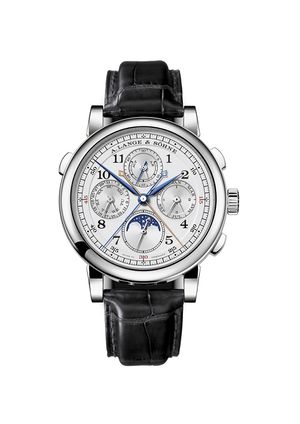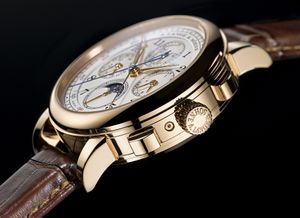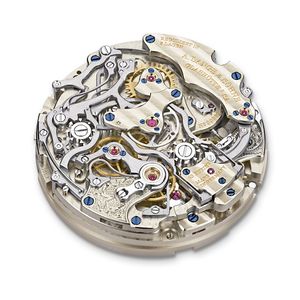A. Lange & Söhne - The legacy of a grand tradition: 1815 RATTRAPANTE PERPETUAL CALENDAR
Glashütte, January 2013
The 1815 RATTRAPANTE PERPETUAL CALENDAR melds the technical fascination of a rattrapante chronograph with the enduring precision of a perpetual calendar that does not need to be corrected until the year 2100, and then by only one day.
The meanwhile eighth chronograph calibre developed by A. Lange & Söhne is yet another manifestation of the brand’s exceptional competence in this apotheosis of precision watchmaking. With a rattrapante chronograph, a perpetual calendar, a moon-phase display, and a power-reserve indicator, it unites more horological complications than the well-organised dial suggests at first sight.
Rattrapante chronograph
Since the presentation of the DATOGRAPH in 1999, the eminent manufactory had repeatedly raised the bar in the design of sophisticated chronographs with no fewer than seven proprietary calibres, including milestones such as the DOUBLE SPLIT and the TOURBOGRAPH “Pour le Mérite”. The first part of its name already indicates that the 1815 RATTRAPANTE PERPETUAL CALENDAR represents a worthy continuation of the successful series: it joins the top league of chronographs, the so-called rattrapante or split-seconds chronographs. Its push piece at the 10 o’clock position implies that there is more than meets the eye. The mechanism behind it is visible through the sapphire-crystal caseback and ranks among the most fascinating ones in a movement. Stopping elapsed or lap times is handled precisely in the classic manner with two column wheels. The central, superposed chronograph hand and rattrapante hand make it possible to measure any number of lap times within the course of a minute. The minute-counter and power-reserve displays are located at 12 o’clock. The longer blued-steel hand indicates the count of stopped seconds. Conversely, the shorter golden hand in the inner circle tells the owner of the watch when the time has come to replenish the energy of the mainspring via the winding crown.
Perpetual calendar
Of the 636 individual parts of the newly developed manufacture calibre L101.1, more than 200 components are part of the perpetual calendar mechanism. It not only knows the durations of all months in the course of a calendar year but also indicates all leap years until the year 2100. That year, according to the Gregorian calendar, is not a leap year, which is why the date must be manually advanced by one day, with pushbutton convenience. The same applies to all other secular years, the next one being 2200. The paired calendar indications are positioned at 9 and 3 o’clock. The subsidiary dial on the left indicates the date and the day of the week, the one on the right the month and the leap year. The newly designed solid-gold lunar disc beneath the subsidiary seconds dial at 6 o’clock emulates the synodic lunation so precisely that it only needs to be corrected by one day every 122 years.
Homage to the pocket watch
Arabic numerals, a railway-track minute scale, gold and blued hands as well as four round subsidiary dials in a clover-leaf configuration characterise the design of the 1815 RATTRAPANTE PERPETUAL CALENDAR. It is the classic design mantra of the 1815 watch family that has its roots in A. Lange & Söhne’s grand pocket watch tradition. The prominent case in platinum or pink gold with a diameter of 41.9 millimetres rounds out the impressive personality of this horological masterpiece.



